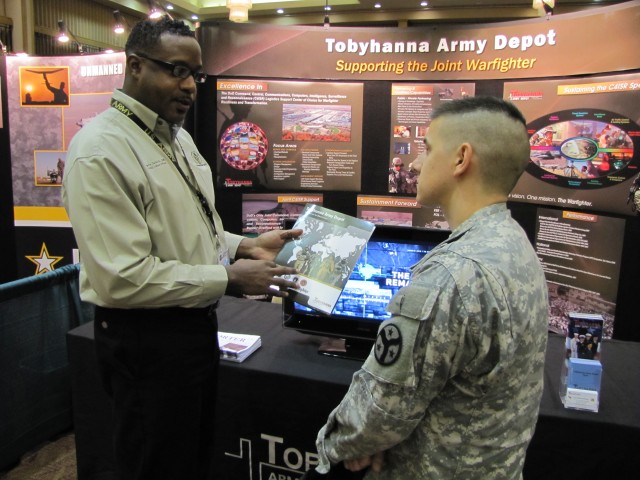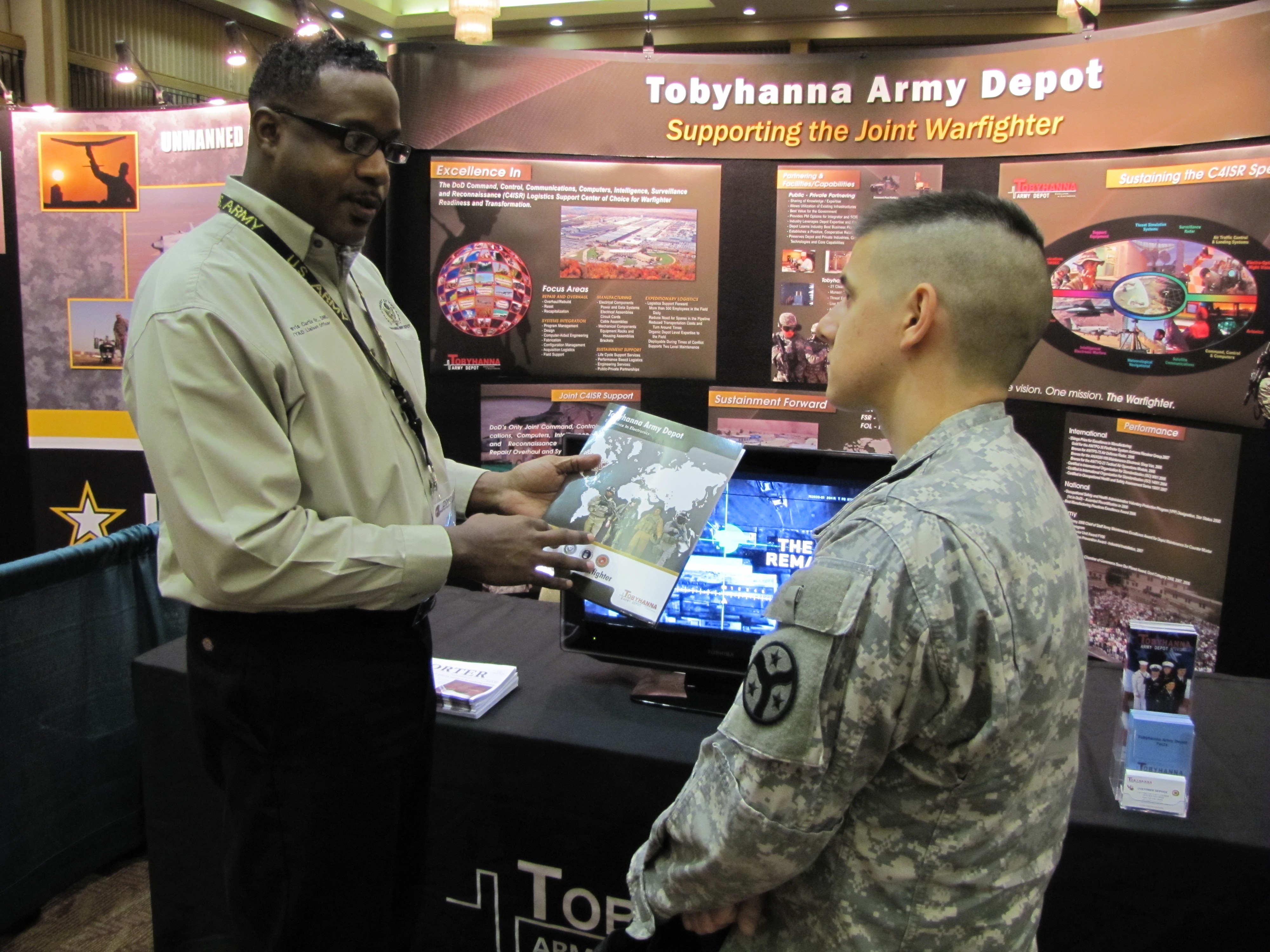
REDSTONE ARSENAL, Ala. -- When it comes to unmanned systems, the Army's scientists and engineers along with program managers and contractors have given Soldiers on the battlefield tools designed to save lives and complete the mission against ever-changing threats.
And those systems are keeping the U.S. one step ahead of the enemy, said Maj. Gen. Jim Myles, commander of the Aviation and Missile Command and Redstone Arsenal.
"This is a war of adaptation," Myles said. "They counter. We counter. I've watched what you did to be an integral part of countering what the enemy wanted to do to us. Unmanned systems save lives. Soldiers are able to learn how to use these systems on the battlefield. You gave them the tools."
Speaking to about 200 attendees at the 21st annual Association of Unmanned Vehicle Systems International symposium hosted by the Pathfinder Chapter of AUVSI at the Von Braun Center on March 17, Myles mostly wanted to thank the government and contractor representatives who have made unmanned aircraft and ground systems an integral part of being on the winning side in Operation Iraqi Freedom and Operation Enduring Freedom.
He added that Iraq and Afghanistan are "the best test grounds to keep growing unmanned systems" by introducing new capabilities and better ways to integrate unmanned with manned systems.
Talon, a portable robot designed for missions ranging from reconnaissance to weapons delivery, along with tiny camera robots that can be thrown onto roofs, behind doors and into tunnels and a host of unmanned aircraft systems are giving Soldiers additional intelligence capabilities without further threatening lives.
"You're saving Soldiers lives in a powerful way and I'm in awe," Myles told his audience, adding that both conventional and special operations forces have come to rely on the capabilities of unmanned systems.
He especially thanked the unmanned systems industry for its initiative in developing robotic capabilities without waiting for a government requirement.
"If you had, the war would have been halfway over before you got the requirement," Myles said. "You've opened up an incredible network of options to see the enemy and ourselves in ways we never thought we could."
Myles, who recently visited Soldiers in Afghanistan, said robots help Soldiers to better detect between friend and foe, and civilian and enemy. That's important in the urban battlefield where it's difficult to distinguish between "bad guys and good guys, and to find the target and take them out," he said.
Unmanned systems "allow us to dominate the battle space we never thought we would be able to dominate," the general said. "Commanders in the field are saying 'I have a lot of things that can kill things. What I need is something to connect the dots. I need the eyes to see the enemy.' This is an incredible capability that we didn't have in the past that you are now providing us and you're providing it in real time."
Although unmanned systems represent a small percentage of the Army's research and development budget, they are contributing tremendously to the Army's ability of "staying inside the enemy's decision cycle ... Unmanned systems are increasingly important to full spectrum operations. There is an increasing reliance on unmanned systems to reduce manpower requirements, risks and casualties and cost," he said.
The mission of unmanned systems has grown in the areas of reconnaissance, surveillance and target acquisition; communications relay; chemical, biological, radiological and nuclear detection; transport and attack.
During his time in Afghanistan, Myles got a bird's-eye view of the role of unmanned aircraft systems on the battlefield. As his Black Hawk helicopter approached Bagram Airfield, Myles' pilot was told it was number three to land behind a Warrior and a Shadow, both unmanned aircraft being flown by ground operators.
But, while its been proven that unmanned aircraft can be safely flown in the high tempo airport airspace of Bagram, Myles said it still remains difficult to convince the Federal Aviation Administration that unmanned aircraft can be flown safely in national airspace. The general said unmanned aircraft should be given the same considerations as hot air balloons and gliders.
"We must work together to convince the FAA," he said.
Myles said Soldiers are definitely sold on the abilities - and safety -- of unmanned aircraft systems on the battlefield. The Army is now standing up a new Combat Aviation Brigade that will include an unmanned aircraft system battalion.
Giving AUVSI attendees an operational perspective of the unmanned aircraft systems roadmap, Col. Greg Gonzalez, project manager for Unmanned Aircraft Systems, Program Executive Office for Aviation, said unmanned aircraft systems have reached a significant achievement - the 1 million flight hours mark.
"One million flight hours is not important in and of itself," he said. "It's 1 million hours of aircraft flying in the air to ensure that routes are clear; to train our pilots; to make sure that people that are emplacing IEDs (improvised explosive devices) don't do so again; to track people back to weapons caches -- a million hours of that activity."
The Army has nearly 1,000 unmanned aircraft systems in theater. And it is continuously introducing new technologies and pushing the envelope of capabilities.
"We have a lot of new things going into theater that will fly more hours and add more capability," Gonzalez said, mentioning improvements in the Raven, Shadow and Hunter.
Specifically with the Shadow, the system is getting a longer wing system that "allows it to stay aloft instead of five hours for eight hours at a time, and increases its payload," the colonel said.
The Shadow has been a standout in unmanned aircraft systems, with two Shadow units reaching more than 2,600 missions and more than 13,000 flight hours in Operation Iraqi Freedom since December 2008.
Myles said its time to start asking "what do we want from our unmanned systems today, tomorrow, five years from now, 10 years from now' And we have to understand how we are going to work with manned systems ... We have learned that as we get more unmanned systems there are more manned requirements out there. We have to ask what the mix ought to be. There is enough room on this battlefield for manned and unmanned systems."
The use of unmanned systems helps Soldiers out there, said Myles. "They are protecting our way of life. It's an away game and we kind of like it being an away game ... Soldiers are doing great. This is what they do for a living. The up-tempo is high. But re-enlistment rates are as high as ever. When you see a 17, 18, 19, 20-year-old in uniform, thank them ... You are making such a difference to our Soldiers' lives."

Social Sharing